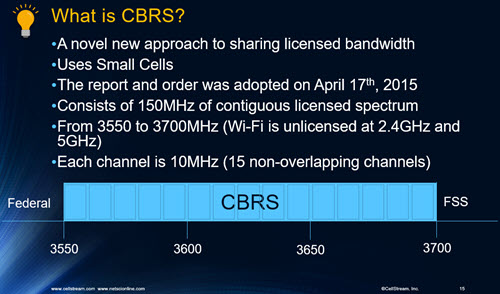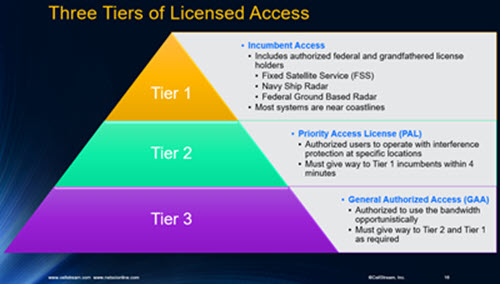If you haven’t heard by now, there is a new and innovative way to allocate wireless spectrum. It is called CBRS – or Citizens Broadband Radio Service. In our opinion every service provider, rural or otherwise, should be actively engaging this new methodology and ramping yup their awareness and participation in CBRS. In fact, especially in the rural areas, this is much more important than 5G (only the 5G people won’t agree with that).
So let’s do a quick overview.
 CBRS is a new and innovative way to share licensed (and that is important) wireless bandwidth between 3.5GHz and 3.7GHz. This means it is in between Wi-Fi’s 2.4GHz and 5GHz spectrum, and this gives CBRS a decent coverage footprint (unlike so much higher wavelengths that won’t go very far at all). This 150MHz of spectrum is divided into 15 channels.
CBRS is a new and innovative way to share licensed (and that is important) wireless bandwidth between 3.5GHz and 3.7GHz. This means it is in between Wi-Fi’s 2.4GHz and 5GHz spectrum, and this gives CBRS a decent coverage footprint (unlike so much higher wavelengths that won’t go very far at all). This 150MHz of spectrum is divided into 15 channels.
Now these 15 channels are not fully vacated per se. There are legacy systems that are using this spectrum – primarily ship born radar, coastal radar and few satellite earth stations. These incumbent systems have priority close to where they are located. So how does the FCC allow the rest of us to use this spectrum? The answer is, again, quite innovative. A centralized database and coordination system will, in real time, coordinate licensed users of the spectrum. This is system is calles the SAS or Spectrum Access System(s). Channels will be assigned and power levels managed by the centralized system(s). They are redundant and all Internet based. More on these below.
What can CBRS be used for? It is a powerful question and answer, with use cases that have already begun to prove their worth in initial systems installed. First, because this is lcensed spectrum, interference is essentially a non-issue (unlike unlicensed Wi-Fi).
Here are a few possibilities:
-
- Smart Cities, Smart Towns, Smart Farms
- Private LTE Network Services (that’s right, LTE works over CBRS!)
- Private (enterprise) wireless connectivity for the Internet
- Redistribution of Public LTE Services (providing connectivity for big carriers in rural spaces or crowded environments like airports/stadiums/theme parks/hospitals/schools)
- Radio Backhaul for wired and wireless systems

- Wide Area Wireless for the Internet of Things/Sensors
- Lower cost public wireless services than W-Fi based systems
- 5G performance without 5G
- more….
How will the licensing work, you may be thinking? The answer is that there is a tiered model (as shown). You can find the FCC details on the 3.5 GHz CBRS band here: https://www.fcc.gov/wireless/bureau-divisions/mobility-division/35-ghz-band/35-ghz-band-overview
There are exclusion zones for the Tier 1 incumbent systems. Overall these are fairly limited. There are also sensors by these zones that provide feedback to the automated SAS system. Cloud based frequency management – that is what this all sounds like to us!
PAL licensing/bidding opens June 25th, 2020, which is right around the corner. GAA Licensing is first come first served. That said, the way the channels will be allocated, always ensures there is some space available for all tiers.
Furthermore, licensing is being done by county in the US (called blocks). Here is an example of the opening bid pricing:

You can download the complete bid spreadsheet here: https://www.fcc.gov/auction/105
Once you have a license, you will also need a relationship to one of the SAS (Spectrum Access System) providers. Currently there are five approved SAS providers:
- Amdocs
- CommScope
- Federated Wireless
- Sony
Once you have your account with them, you will use them to install/log your CRBS systems called CBSD’s (Citizen Broadband Service Devices) and their respective antennas. You cannot do this step with the use of a Certified Installation Professional or CPI. Mr. Walding is a CPI – you can read more here on his services.
Only CPI’s can enter you system/antenna into the SAS database. Once this is accomplished, the SAS uses the Internet to communicate to the CBSD and provisions it for safe operation.
If you are ready to do a deeper dive, and you need to get ready for this technology, we provide one day workshops on CBRS. You can look here for the schedule of these events/sessions and details regarding attending in your area. Just navigate the calendar to find sessions. Many of them are being coordinated through state telecom associations, so also ask your local association if there is one planned. We urge you – especially if you are a rural provider – to attend.

